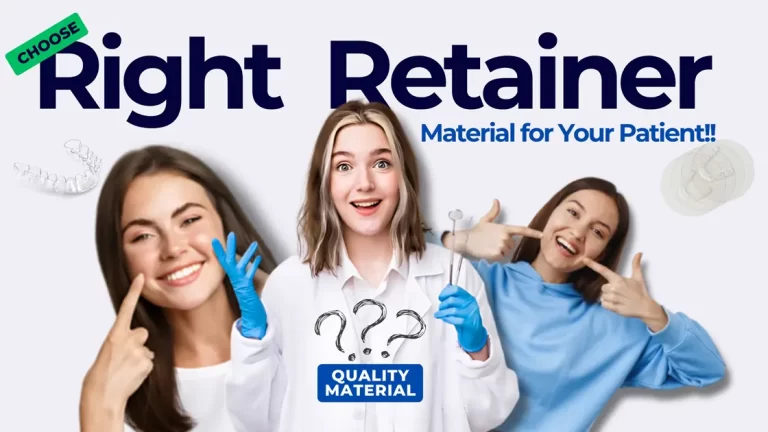Enquire Form
The Power of Choosing the Right Retainer Material

The success of orthodontic care is a life-changing experience that extends beyond stepping out of braces. Equally important is the post-treatment period, and retainers are the basis of this continuous care. These tools are needed to maintain the beautifully aligned smiles that are achieved at the end of the treatment. In this article, we explore the extensive field of retainer materials, learning about their importance, the different types that are available, and the different properties that contribute to their quality.
Importance of Retainers in Orthodontics
Orthodontic Stability:
Retainers are mostly used to preserve the alignment that was obtained after orthodontic treatment. Following the removal of braces or other corrective devices, teeth naturally tend to move back to their previous positions. This is because the surrounding muscles, lips, and tongue are applying continuous pressure. Retainers maintain the teeth in their proper locations and prevent relapse.
Maintaining Treatment Expenses:
Orthodontic treatment is a commitment to time, energy, and money. If a patient wants a beautifully aligned smile, they have to be ready to commit to months or years of treatment. This investment has a high risk of failing if post-treatment care is not maintained. Retainers protect the patient’s investment in their dental health and appearance. They ensure that the outcomes of orthodontic treatment are maintained throughout time
Improving Both Comfort and Function:
Apart from helping maintain the alignment of teeth, retainers help in the general comfort and functionality of the oral cavity. They maintain the bite and help to avoid soreness during speaking and chewing.
Addressing Individual Needs:
Each patient’s specific demands and concerns are taken into account during the orthodontic treatment process. In this approach, retainers are essential since they offer customized support. Depending on the patient’s unique needs, the option may be a set retainer for continuous support or a removable retainer for individuals who might want to remove it from time to time.
Increasing Patient Self-Belief:
A perfectly aligned smile has a positive effect on patients’ minds. Those who receive orthodontic treatment report feeling more confident and good about themselves. Retainers are needed to preserve this confidence as they stop the teeth’s alignment from reversing. Retainers’ continuous stability helps to produce long-lasting psychological benefits.
Lifelong Dental Health:
If orthodontic problems are not treated, they can result in a number of oral health issues, such as uneven wear on tooth surfaces and an increased risk of decay. Retainers aid in preserving the teeth’s corrected positions. They encourage patients to practice the best oral hygiene habits and lower the likelihood of further dental problems.
Total Outcome of Therapy:
The results of a successful orthodontic treatment last for a long time with the help of retainers. This success, which would not have been possible without retainers, guarantees the patient will benefit from a straight, healthy smile for many years.
How Quality of Retainers Affects Post-Orthodontic Care?
The effectiveness of post-orthodontic care is closely related to the quality of the retainers used. Poor-quality materials or ill-fitting retainers can negatively affect the treatment results. This can lead to slow misalignment and dissatisfaction among patients. Choosing superior retainer materials is not just a professional decision; it’s a commitment to the continued success of orthodontic treatment and the satisfaction of patients.
The durability, comfort, and success of retainers are considerations that highlight the need for high-quality materials. Patients invest time, effort, and money in achieving a perfect smile. This is where the choice of retainer materials becomes instrumental in ensuring that this investment leads to long-lasting results.
Types of Retainers:
Knowing the various kinds of retainers allows dentists to customize treatment regimens to meet the specific requirements of each patient.
Removable Retainers:
- Hawley Retainers: Made of acrylic and metal wires, these retainers are adjustable and long-lasting.
- Clear Plastic Retainers: Made of translucent plastic, these retainers provide a more discreet look and are a good choice for people who would rather have a less noticeable option.
Fixed Retainers:
These retainers, which are bonded to the back of the teeth, offer ongoing support. Stainless steel is usually used to make such wires.
The decision between fixed and removable retainers is frequently impacted by the orthodontist’s professional assessment, lifestyle considerations, and personal preferences of the patient.
Materials Used for Manufacturing Retainers
The materials that are used in the building of retainers are an important factor. The device’s overall effectiveness, comfort, and performance are greatly impacted by the material selection. Typical materials consist of:
- Stainless steel: Stainless steel offers strength and endurance and is frequently used in fixed retainer wires.
- Acrylic: An essential part of Hawley retainers, acrylic adds to the device’s toughness and allows simple adjustments.
- Clear Plastic: This material, which is used in clear plastic retainers, offers a discreet alternative with strength.
Comprehending the distinct characteristics of every material enables orthodontic practitioners to create knowledgeable choices grounded in patient requirements and treatment objectives.
The Important Properties of Ideal Retainer Materials
- Durability is a quality that sets the best retainer materials apart. In order to ensure that the retainer lasts long, the selected material should be able to withstand normal wear and tear.
- Biocompatibility: It is essential for patient safety that the retainer material be biocompatible. Biocompatible materials improve overall oral health by reducing the possibility of allergic responses or other negative reactions.
- Retention Strength: In order to maintain the teeth in their corrected locations, the retainer needs to exert enough force. Sustaining the benefits of orthodontic treatment and avoiding relapses depend on having adequate retention strength.
Taglus is a global industry leader in the manufacture of innovative retainer thermoplastic sheets that are made using cutting edge technology and equipped to meet the most demanding aesthetic standards. Taglus Tuff is the thinnest retainer of 0.8 mm thickness. Its minimum thickness combined with ideal mechanical properties makes it ultra comfortable to wear and offers maximum durability.
Maintenance of Retainers:
Maintaining retainers is important to their longevity and performance.
Regular Cleaning:
To avoid the growth of bacteria and to preserve cleanliness, removable retainers should be washed once a day with a non-abrasive cleaner.
Professional Check-ups:
Scheduling routine appointments with the orthodontist makes it easier to evaluate the state of the retainer. Professional examinations help in making any adjustments to the retainer and guarantee ongoing efficacy.
The Future of Retainer Materials: Innovations and Advancements
The field of orthodontics is always changing as technology develops. Future developments in retainer materials promise increased efficacy, comfort, and durability. Researchers are looking for flexible, biocompatible materials that can adjust to teeth’s natural movements to provide a more seamless and enjoyable orthodontic experience.
Conclusion:
In summary, the selection of retainer materials in orthodontics is a critical decision that directly affects patient happiness and treatment effectiveness. Orthodontists can raise the bar for post-orthodontic care and help patients have long-lasting smiles by appreciating retainers, assessing the variety of styles and materials available, and emphasizing their aftercare.
Beyond the treatment stage, the dedication to orthodontic perfection continues with the careful selection of retainer materials, a choice that has a long-lasting effect on patients’ lives. The properties of TAGLUS Tuff sheets make it an excellent choice as a retainer material. Selecting top-notch retainer materials is a sign of dedication to excellence and a promise to create long-lasting smiles from experts.
References:
- Lyros, Ioannis et al. “Orthodontic Retainers-A Critical Review.” Children (Basel, Switzerland) vol. 10,2 230. 28 Jan. 2023, doi:10.3390/children10020230
Know More About Us
SignUp To Our Newsletter And Get To Know More About Taglus
Copyrights@taglus-2025
*Taglus is a trademark of Vedia Solutions










Leave a Reply